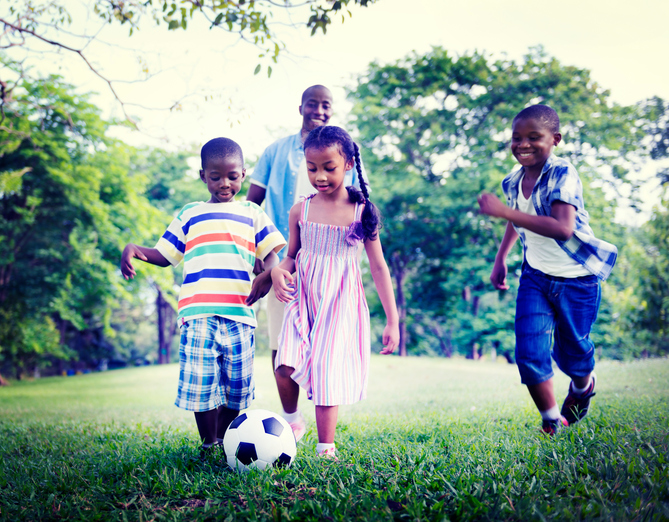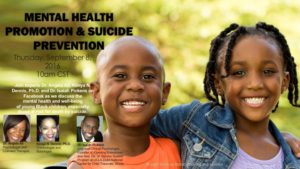
The village needs healing. Suicide ranked 14th as a cause of death among Black children in 1993-1997, but increased to 9th in 2008 - 2012. In a 2015 study published in JAMA Pediatrics looking at suicide among elementary aged children aged 5 to 11 years, the rate increased significantly for Black children - in particular Black boys - while it declined for White children.
What's behind these findings?
 BlackDoctor.org in partnership with the Substance Abuse and Mental Health Services Administration (SAMHSA) launched a national conversation on preventing suicide and promoting positive development among African American children, beginning with the "Mental Health Promotion and Suicide Prevention Facebook Chat" on September 8. Leading mental health experts Dr. Angela Ali, Kimya N. Dennis, PhD and Dr. Isaiah Pickens discussed the mental health and well-being of young Black children, especially those at risk for death by suicide.
BlackDoctor.org in partnership with the Substance Abuse and Mental Health Services Administration (SAMHSA) launched a national conversation on preventing suicide and promoting positive development among African American children, beginning with the "Mental Health Promotion and Suicide Prevention Facebook Chat" on September 8. Leading mental health experts Dr. Angela Ali, Kimya N. Dennis, PhD and Dr. Isaiah Pickens discussed the mental health and well-being of young Black children, especially those at risk for death by suicide.
Dr. Angela Ali is a Chicago-based Psychologist & Licensed Therapist.
Dr. Isaiah Pickens is a Licensed Clinical Psychologist based in LA, founder of iOpening Enterprises, and Assistant Director of of the Service System Program at the UCLA-Duke National Center for Child Traumatic Stress.
Kimya N. Dennis, PhD is a sociologist and criminologist with interdisciplinary research and community outreach dealing with suicide and suicidal self-harm, mental health, and reproductive freedom.
YOU MAY ALSO LIKE: Black Boys, Suicide & Shame: What Can The Village Do?
On the following pages is a transcript of this informative live chat, exploring ways to address this urgent issue and engage parents, national organizations, health professionals, community and faith-based organizations and anyone who believes in promoting positive mental health in Black children.
For additional resources and information visit the SAMHSA website at www.samhsa.gov. If you or a loved one is in need of help, call the National Suicide Hotline: 1-800-273-8255.
Q1. What do we know about the rates of suicide among Black youth?
Dr. Angela Ali What we know is that the rates of suicide are somewhat less than the national average, however still high...especially among young black males.
Kimya N. Dennis, PhD Yes, rates are increasing but still lower than national average. This varies across gender.
This is still important because, as with the case for Black suicide as compared to white suicide, a "lower across-racial rate" does not mean there is not an issue worthy of research and discussion.
Q2: What are the factors that can place youth at risk for suicide?
Dr. Isaiah Pickens One of the strongest predictors of suicidality is hopelessness. Recent research by Lisa Hooper and her colleagues has also shown that reactions to trauma can heighten suicidal thoughts. Despite the growing presence of programs that try to address young Black men’s needs like the Obama Administration’s My Brother’s Keeper initiative, many young Black boys face traumatic experiences such as community violence and adverse childhood experiences such as exposure substance use that can increase a sense of hopelessness and may play a role in the rising rate of suicidality. In addition, access to services plays an important role for assessing suicide risk and treating underlying depression that may be driving behavior. Historically, disparities in access to healthcare coupled with stigma around using health services has placed Blacks who are experiencing mental health challenges at greater risk for not having treatment.
Dr. Angela Ali Common events that take place in our communities...such as violence and death can lead to traumatic stress in youth. Gone untreated, this can result in depression and anxiety that can lead to thoughts of suicide.
Kimya N. Dennis, PhD I work on this in terms of social and psychological factors. Including how girls and women are taught to be consumed with helping other people rather than themselves. Boys and men are taught "hetero-masculinity" meaning they should be unemotional, not get help if needed, and unattached to other people.
There are also cultural issues when most cultures are told that religiosity overcomes everything and doctors cannot be trusted. This encourages self-diagnosis, self-medicating, and self-healing.
Q3: What are the risks, particular to young Black boys, for depression? For suicide?
Dr. Isaiah Pickens Risks for depression are multifaceted, with some risks being biological in nature such an individual having a neurochemical predisposition that lead the brain to produce fewer neurochemicals necessary to elevate or stabilize mood, and other risks being environmental such as traumatic and adverse life experiences. Among many of our young Black boys we see perceptions of hypermasculinity that can lead to pressure to act a certain way, distort perceptions of self, or create a barrier from getting the support necessary when signs of depression first start as contributors to depression and place them at risk for suicide.
Dr. Angela Ali I'm addition to post-traumatic stress that results from ongoing violence, the early onset of puberty can be a catalyst for higher risks of aggression and other mental health disorders.
Kimya N. Dennis, PhD Cisgender culture and socialization: From birth most cultures make assumptions of what biological males think, believe and are physically capable of doing. As with all people, this makes it almost impossible for boys (and men) to know their own thoughts, beliefs, preferences, and behaviors. Therefore, they tend to lean on what they have been taught and told to do.
This impacts the cisgender and hetero-masculinity beliefs that boys should never be sad (and never tell anyone when they are sad), should never feel pain; only girls, women and "punks" get depressed; and suicide is a "sissy" action UNLESS it is done to save the lives of people you love.
This view of suicide as sometimes appropriate is a culturally historical perspective that ties into how murder-suicide, suicide-by-cop, suicide bombers, and suicide-for-the-sake-of-others (example: historical perspectives of Jesus) are considered indicative of how "real men" can end their lives.
Q4: Who needs to be involved in promoting health and preventing suicide among Black youth?
Kimya N. Dennis, PhD Families, schools, mental health organizations (which does NOT mean most people who consider, attempt, and complete suicide have diagnosable mental health conditions), and other community organizations.
I do a lot of community outreach with particular emphasis on Black and African diaspora communities. Reduce the shame and reduce the "religion is the only answer for everything". We need people (including sports coaches) to stop using the word "punk" so loosely. We need people to be informed, knowledgeable, and conscious but STILL go to medical professionals. This does not mean medical professionals are 100% accurate--that is where WE must take some onus and motivate ourselves to live healthy and informed lives.
This also does not mean we will "baby" youth and have trigger warnings for everything that can potentially hurt someone's feelings. Instead, it means we are challenging cultural ideologies and encouraging people to get help even when they think they can "heal themselves" or believe there is not even a problem.
Dr. Angela Ali You're right...the shaming along with the rigid and narrow ways that we interpret religion hurts us in more ways than we can imagine. This includes hurting us in those areas that mean so much to our overall health and existence...such as mental health.
Dr. Angela Ali When it comes to prevention and awareness, we are lacking the consistent and active involvement of community agents. These would be our churches, schools, and other organizations. Suicide, along with other social issues that tend to be subjects of 'moral failings' continue to go undiscussed and therefore we are inept in our ability to effectively detect and prevent it.
Q5: At what age can children start suffering from depression or other effects of trauma? What are the symptoms that parents should look for?
Dr. Isaiah Pickens Children can begin suffering from depression as early as 6 or 7 years old (and sometimes earlier) depending on the life situations that trigger the depression. However, the signs of depression may look different in kids than adults. Instead of a "depressed mood" parents may see irritability or aggressive behavior. Also, if kids have trouble concentrating, falling asleep or sleeping too much, or problems with their appetite, these are signs that kids may be suffering from depression. In addition, if kids stop caring about things they used to care about or don't seem to want to spend time with others like they used to then this may be a sign that your child is suffering from depression, particularly if this has been happening consistently for the past week or two.
Kimya N. Dennis, PhD Ages 3-5. Most medical and mental health experts dismiss young child trauma. This is why medical and mental health experts need to keep up with new research and receive additional training throughout their careers.
Parents and other adults need to look out for continual sadness, changing moods, and negative stimuli in the child's life.
However, this is difficult when there are cultures that essentially teach children that "life sucks...get over it." For example, there are millions of Black children raised in environments where there are few happy days. Sadness, negativity, and violence are "just a way of life." It is even the case that Blacks who appear happy and are smiling are told "why are you so darn happy" and even "you must not really be Black."
We need to be honest about these types of environments because it correlates with why many Blacks refuse to get help for mental and physical conditions. They don't trust doctors (for legitimate reasons) and have always been taught that pain and misery are "the reality of Blackness."
Q6: What methods exist for early screening and intervention to identify warning signs of suicide?
Dr. Isaiah Pickens There are several suicide programs for the community to learn how to screen for suicide and screening tools available for mental health and other professionals to use for early prevention. NIMH has a great screener that anyone can use. A couple of important things to remember for helping family and friends with suicide: 1. Ask directly about thoughts of killing yourself. It really decreases the stigma and will not increase risk. 2. Explain that you are concerned and want to help them deal with their pain even though you can't imagine exactly what they are going through. 3. Connect them with resources. Whether it is mental health treatment or if it is a crisis calling the National Suicide Hotline: 1-800-273-8255.
Dr. Angela Ali Where we may screen for hypertension or eye health, we can also screen for mental functioning.
Dr. Angela Ali There are screening tools and assessments that can be administered to identify if someone is suicidal. There should be more preventative initiatives in our communities that screen for signs and symptoms of suicide, and mental illness in general.
This can take place where we often frequent such as barber shops, schools, churches, etc.
Q7: What protects young Black boys, in particular, from depression or thoughts of suicide?
Dr. Isaiah Pickens Three of the biggest protective factors are being able to connect with a community, tackling anything that contributes to hopelessness, and help developing problem solving skills. You can do this by helping kids better understand what they are feeling, triggers for the feelings and how these triggers are connected to their behavior and relationships, and finally help them learn healthier ways to achieve their goals and find meaning in the things that they do.
Dr. Angela Ali In so many ways, our young Black boys don't feel valued or safe within society. Therefore, initiatives that counter feelings of hopelessness and increase self-esteem certainly can help. In addition, if parents or other family members notice young Black boys consistently acting out in anger, being aggressive, pessimistic, or overly reserved, there is cause for concern. It never hurts to seek help from a mental health professional to determine that youth's level of mental functioning.
Kimya N. Dennis, PhD There are potential protective factors such as strong family environment, strong school environment, and positive peer environment.
"Strong" means these environments are mentally and physically healthy. They are conducive to mental and physical support. They are also conducive to Black boys knowing their OWN personality, beliefs, and life goals while ALSO developing more positive traits and goals.
Q8: How can parents, schools, community organizations, etc. better support at-risk groups of youth, like those who are bullied, known to have higher rates of suicidal behavior?
Dr. Isaiah Pickens One important strategy is to create more trauma-informed school and communities that recognize how trauma can impact the way kids deal with the world. I work for the National Child Traumatic Stress Network, funded by SAMHSA, and our mission is to help parents, schools, community organizations and others recognize the impact of trauma on kids, particularly our most vulnerable and marginalized groups. One practical step that all parties can take is acknowledging the psychological pain some of our youth are experiencing and affirming that they are loved no matter what their struggles or identity may be. This is particularly important for our youth from groups who receive greater levels of harassment such as the LGBT community, immigrants, incarcerated youth, etc.
Dr. Angela Ali If a child is reporting that they've been negatively affected by social media interactions, don't take it lightly.
Dr. Angela Ali The world of social media has changed the way that youth (and others) engage with one another, and that engagement can be very damaging. Schools, parents, etc. must be hyper-vigilant in understanding how these newer ways of communicating can negatively affect a youth's psyche and result in depression.
Kimya N. Dennis, PhD Encourage children to talk to an adult when they need to talk to someone.
This means adults need to be available and not "too busy." Adults cannot just tell a kid she/he is being silly or overly emotional. Don't tell boys to "be a man" or tell girls that they are being like the movie "Mean Girls."
But the first model for this has to be parents and family.
School and community orgs cannot replace the family. When families are unavailable, not involved and unconcerned the child essentially feels like she/he is an orphan.
I also do research and presentations on the childfree-by-choice in which I encourage people to think consciously about having children. Having children is not a requirement and there are now more methods for hetero-women AND hetero-men to reduce the likelihood of pregnancy. People need to think consciously about the commitment needed to have children. Think consciously about the hard work needed to have children. Accept the reality that having children is not about "perfect adorable kids who have NO problems and can basically raise themselves." That is not true and it isn't the job of schools and the community to raise your child.
Q9: How do we make the connection between the grassroots level and the higher level research to better help the community address and prevent Black youth suicide?
Dr. Isaiah Pickens 1. We need to improve our health messaging about research and scientific best practices to make it more accessible to the general public. This is something that I blogged about recently as it relates to translating mental health supports for the community and police. 2. It is important for those who fund research to promote community participatory research practices. Communities can support this by lobbying their congressional officials to promote research that fully incorporates the community. 3. Finally, the community has to participate in projects that are engaging the community and urge their community organizations (i.e., churches, Boys and Girls clubs, etc.) to integrate more mental health based programs. Also, it's important for Blacks to volunteer for research projects because that's how we figure out what works in our community.
Kimya N. Dennis, PhD I encourage people to stop "reinventing the wheel" and, instead, to contact various local, regional, and national/international organizations.
All of my work is interdisciplinary. I work with mental health experts, psychologists, psychiatrists, etc. We are all doing work. All of these topics have been studied for CENTURIES by researchers and practitioners in criminology, criminal justice, sociology, psychology, psychiatry, various medical experts...the list goes on.
If more researchers, practitioners, social activists, and organizations would encourage interdisciplinary work, this would be less of an issue.
If more people stopped competing and wanting credit for "discovering the (figurative) golden calf" there would be more work (and more grants and funding) to address REAL ISSUES.
Dr. Angela Ali For one, Blacks currently within the mental health profession, as well as other organizations can help bridge this gap by advocating for more Blacks to go into the field. There is an averse shortage of us within the profession, yet we have much to offer in terms of cultural competence. Also, most Blacks want to engage with a Black therapist when they decide to get help. We actually have access to the research and best practices for treating our own.








